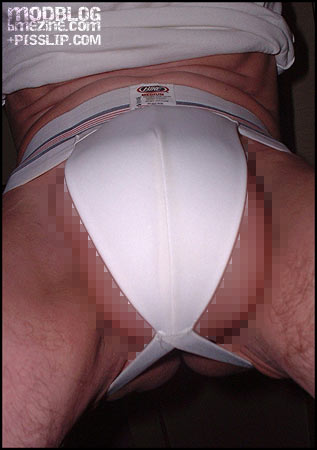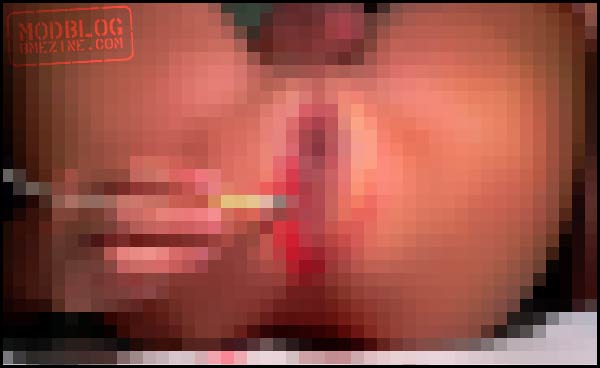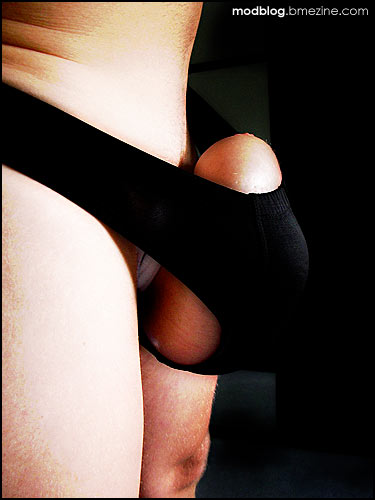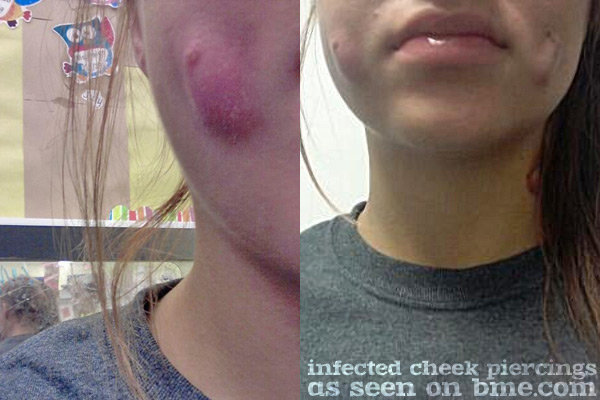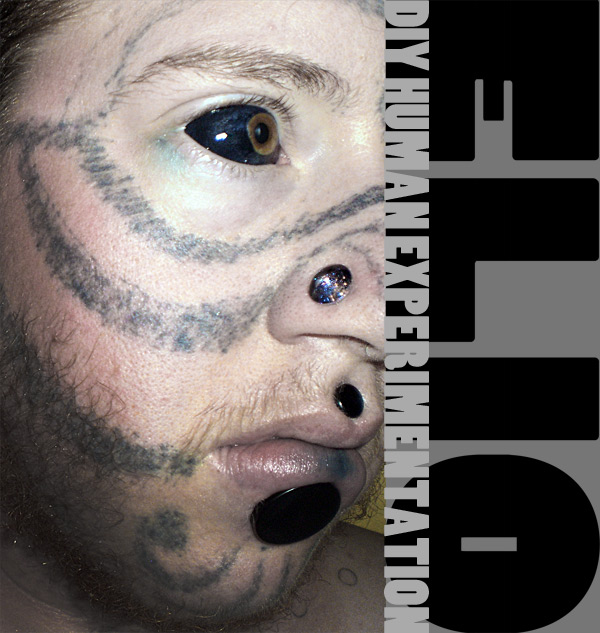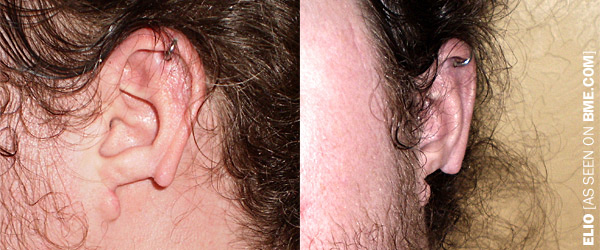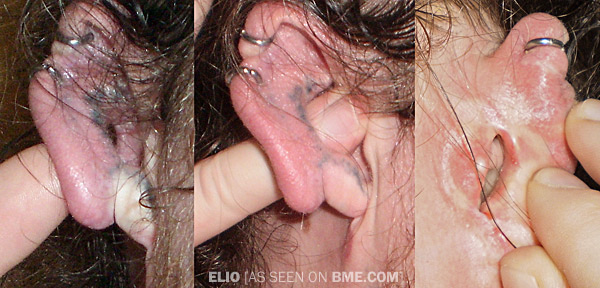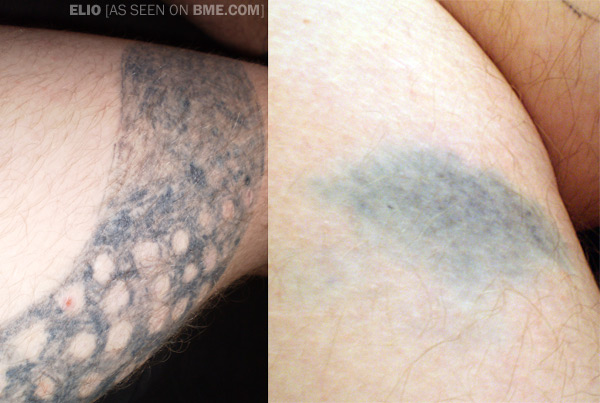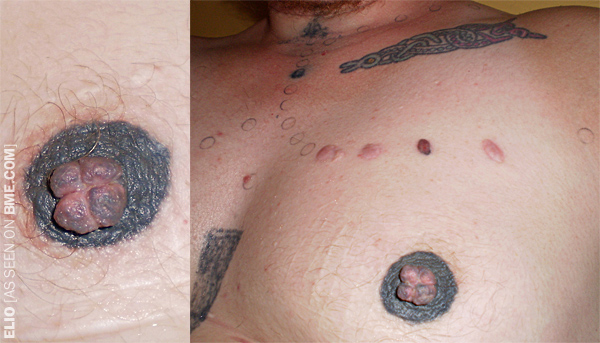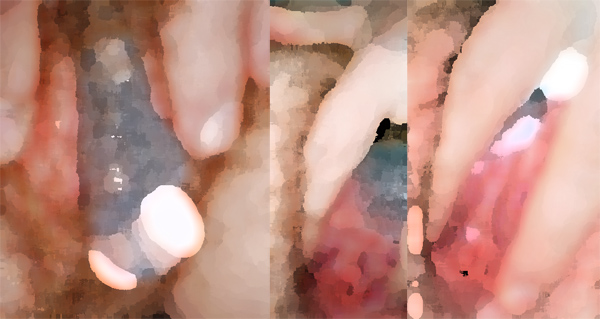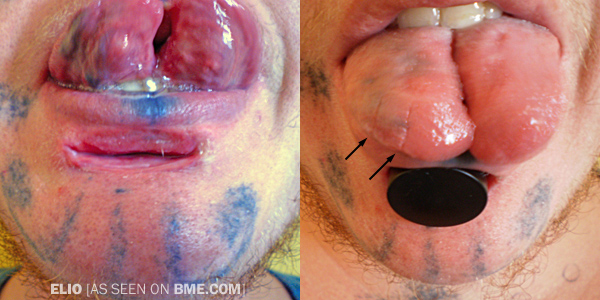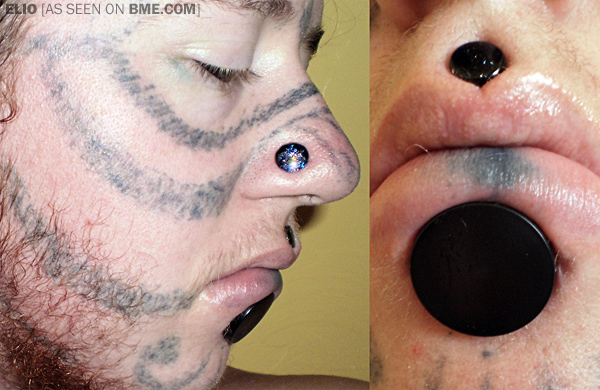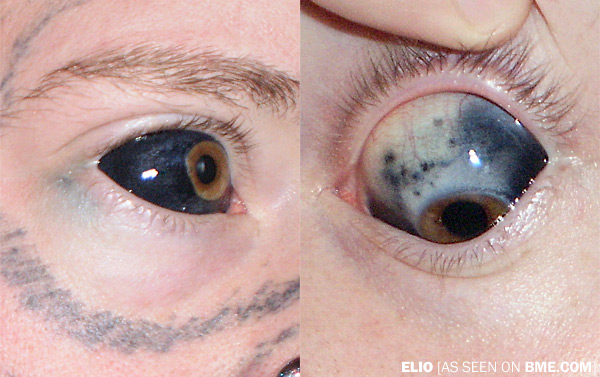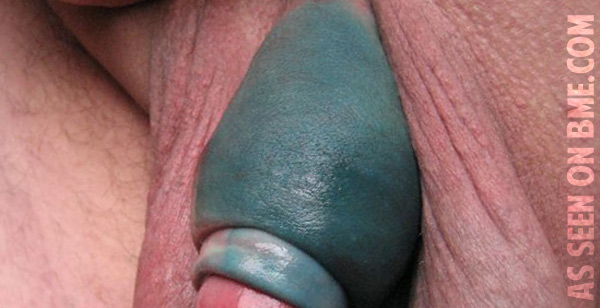
**Please note that as of 2020, there have been a few documented cases of both temporary and permanent blindness associated with this procedure. The risks are great and real and this procedure has been banned in several places because of the risks it poses. – BME**
Eyeball Tattooing FAQ
by Shannon Larratt
INTRODUCTORY NOTES
- Unless otherwise indicated, this document refers to scleral tattooing (over the white of the eye) using the ink injection method, rather than to corneal tattooing (over the iris) using repetitive needle punctures.
- This document is under constant revision and reflects the current amateur understanding of the art of eyeball tattooing. It should not be taken as definitive or absolute advice. This document is not medical advice. This document will be updated whenever relevant and possible, so please check back for updates.
- Eyeball tattooing carries with it significant risks up to and including blindness and life-threatening complications. Nothing in this document should be taken as condoning or recommending or encouraging eyeball tattoos, or presenting it as safe. Proceed at your own risk.
- Because this FAQ is constantly changing, please do not reprint it elsewhere. Instead, please link directly to BME.com where it is hosted: http://news.bme.com/2012/10/18/the-eyeball-tattoo-faq/
FAQ REVISION HISTORY
Current Version: 1.1 / November 21, 2012
Updates since the previous version are highlighted in red (like this).
1.1 – Added additional risks information (glaucoma, ocular hypotension, etc.), multicolor inks, and various notes.
1.0 – FAQ updated after long talk with Howie/LunaCobra
0.9 – Original version written by Shannon Larratt
** What is eyeball tattooing?
Eyeball tattooing, in the context of this FAQ, is the process of permanently altering the color of the eye. Generally this refers to the injection of ink under the surface of the white of the eye, rather than changing the color of the iris, although this is theoretically possible.
** Why would someone want to tattoo their eye?
This is a rude question that no one should feel obligated to answer to anyone but themselves. But to generalize, people get eyeball tattoos for the same reasons people would get any tattoo or make any permanent change to themselves — because it makes them happy or feels right in some way. Because they like the way it looks. Because it suits them spiritually. Because they find it sexually appealing. Because they want to differentiate themselves from others. Because they feel tattooing has gotten to mainstream and want something more socially offensive. Because they saw it in a dream. Because it appeals to them as an artist. Because they want to make a political statement. Because they’re mad at their mommy for not hugging them enough. Because it’s none of your business.
** Wouldn’t it be better to just wear full-eye (scleral) contacts?
Full-eye or scleral contacts are typically extremely uncomfortable and hard on the eye. Special effects lenses of this type (versus specialty medical lenses) are not intended to be worn for more than a few hours at a time, no more than six hours at a time, and only occasionally. Wearing scleral contacts on a constant or even regular basis carries with it significant medical risks and is probably much more dangerous than eye tattoos. However, if you’re not sure this is something you want to commit your life to, this could be an excellent but temporary alternative.
** How, anatomically, is an eyeball tattoo different from a normal tattoo in skin?
The structure of the dermis/skin is anatomically very different from the structure of the eye. A tattoo in the skin is below the constantly regenerating epidermis, with the ink being deposited inside the more stable dermis. The particles of pigment become trapped among the cells of the dermis. In an eyeball tattoo, the pigment is trapped between the conjunctiva and the sclera of the eye — squeezed between two flat layers, like jelly in a sandwhich. In the case of corneal tattooing, the ink is below the corneal epithelium, sitting significantly above the iris. It is not placed into the iris itself, which is much deeper. While ink in a standard tattoo is effectively locked in place, ink in an eyeball tattoo can remain mobile, and is able to shift or even migrate fully out of the eye years after the procedure is done.
** What are the different procedures used for eyeball tattooing?
The two main methods of applying the ink beneath the surface of the eye are using individual pokes of a needle or cluster of needles in a method similar to traditional tattooing, and by using a syringe filled with an ink solution to inject a “cloud” of ink under the conjunctiva which spreads over a significant area. With the traditional needle method, it is typically done by hand rather than with a tattoo machine, although tattoo machines are sometimes used.
** What are the pros and cons of the different methods?
Using a traditional tattoo method, where a needle dipped in ink is repeatedly poked into the eye, theoretically allows for complex designs to be performed. Because the ink only spreads minimally, tattooing over the iris/cornea is possible, in addition to tattooing over the white/sclera. However, because each hole applies only a small amount of ink, a great deal of damage must be done to the conjunctiva. This is especially true if an electric tattoo machine is used, which can quickly destroy the surface of the eye. In the short term, the multiple holes, whether created by hand or by machine, can cause some or even all of the ink to be rejected by the eye, and in the long term can result in complications such as recurrent erosions (where the layers of the eye do not properly reconnect), as well as persistent abrasion and ulceration of the eye. These can be extremely painful and risk the health of the eye and compromise vision. Doctors have found that loss of ink is minimized when the angle of the needle is as lateral (flat, rather than straight in) as possible.
Using the injection method of eyeball tattooing, where a larger area of ink is injected via a single hole, complex designs are not possible, and although fades from one color to another are possible to some extent, they can be difficult to control and master. The difficulty in controlling the spread of the ink makes this method inadvisable for the cornea (ie. over the iris and pupil) because of the danger of obscuring vision if the ink spreads over the pupil. Because only a few injections are required to completely cover the white of an eye with ink, many of the risks in the traditional method such as significant ink loss and ulceration are largely mitigated (although they are not eliminated). However, the injections can be difficult to control, and over-injection or injections that are too deep or too shallow carry significant risk — the appropriate zone is less than a millimetre thick, with serious consequences for missing it.
The medical community uses almost exclusively the traditional tattoo method — although even after 150 years they have not come up with an agreed upon technique, which is very telling — whereas the body modification community uses almost exclusively the injection method. To date, attempts to tattoo the white of the eye using traditional needle methods have been extremely unsatistfactory, almost completely falling out. The general consensus is that injection is the only acceptable method of scleral tattooing.
** What is the history of eyeball tattooing?
The earliest references to medical tattooing of the eye dates back almost two thousand years, with Roman doctors treating white patches over the iris by first branding them and then applying dye in an attempt to stain the cornea to match the iris. After the Roman era, doctors seem to have avoided it until the 19th century when doctors started using a needle and ink method to tattoo the cornea to repair deformities and opacities. A variety of different needle designs were tried — grooved needles, needle clusters, early tattoo machines and so on. Even now new techniques continue to be tried because of poor results. A few doctors tried (and continue to develop) more invasive methods of applying the ink. It was not until the beginning of the 20th century that eyeball tattooing was first offered on an elective cosmetic basis, with a number of early tattoo artists running newspaper advertisements offering to change the color of clients irises. Whether anyone actually went through with this and what the results were is unknown, and no references to these services exist beyond about 1920.
The injection method of tattooing eyes was invented by Shannon Larratt and first performed July 1, 2007 by Howie (LunaCobra.net), who has continued to develop and refine the procedure since. Shannon’s ex-wife Rachel had gotten an eyeball implant by Dr. Gerrit R.J. Melles in The Netherlands, one of the developers of the LASIK procedure. He had developed a method for inserting thin platinum jewelry underneath the conjunctiva, rationalizing that it would be safe because the eye has evolved to tolerate calcium buildup in this layer as people age. The implant was inserted by injecting a small drop of saline in order to create a pocket for the implant. Shannon theorized that the saline could be replaced with ink in order to dye the white of the eye and approached Howie about doing the procedure. After performing this procedure on Josh Rahn and Shannon Larratt, as well as attempting a traditional method eyeball tattoo on Pauly Unstoppable, Howie went on to perform the procedure on many others, refining it with an eye to efficiency and safety.
The media immediately picked up on eyeball tattooing and photos were featured in international mainstream media including an episode of CSI which used the injection method as a central plot point. Not long afterwards two inmates on a reality TV show about life in prison tattooed their eyes after seeing photos of Howie’s work, and practitioners around the world began attempting it. It has gotten consistently more popular every day and as of this writing I would estimate there are several hundred people with tattooed eyes.
** Why do doctors tattoo eyes?
Opthalmic surgeons with specialized training sometimes tattoo the eye in order to correct defects such as a misshapen iris or opaque or discolored patches in the cornea. Tattooing is typically used to give the patient a more normal appearance, and more rarely can also be used to address vision problems usually resulting from holes or transparencies in the iris from disease, genetic conditions, or injury letting excess light into the eye and creating persistent glare. Due to the risks, these procedures are almost exclusively done on patients who are blind or who have seriously affected vision. Whenever possible doctors prefer to use contact lenses to deal with these types of problems. New procedures such as corneal grafting are also replacing tattooing.
** Is elective eyeball tattooing legal?
As of this writing only a very small number of jurisdictions have specifically outlawed eyeball tattooing or legally restricted it to trained medical practitioners — for example Oklahoma, which made it a misdemeanour in 2009. In general it is legal, or at least not criminal, pursuant to any local laws and regulations governing tattooing in general. However, in the event of any complications, the practitioner would face potential assault charges and perhaps other criminal charges (even without a complaint), as well as a potential civil suit. Artists are encouraged to consult with their lawyer and to obtain appropriate signed liability disclaimers.
** Can I go to a doctor to get my eyes tattooed?
Doctors are generally not willing to tattoo healthy eyes due to the perceived risk. Additionally, it is highly unlikely they would be willing to do anything beyond the normal correction of defects, both due to personal ethics and due to medical regulation frowning upon atypical procedures. Most Physicians Colleges would not tolerate a doctor willing to perform whole-eye tattooing of the type that is common in the body modification scene.
** Are there any medical conditions that preclude tattooing the eye?
It is strongly advised that anyone with any significant eye abnormalities avoid eyeball tattooing because this adds many unknown risks and could complicate existing conditions. This is especially true for scleral conditions but applies to other conditions as well. Wearing glasses is fine, but corrective contact lenses should not be worn with eyeball tattoos.
** How do eyeball tattoos affect potential future medical conditions or treatments?
It is possible that certain eye conditions, diseases, or disorders may be made more difficult to see by the addition of ink to the eye, especially those that first show via discoloration or abnormalities of the sclera. It is also possible that the tattoo could make treating the eye more difficult or complicate or exacerbate the condition. Even in the case of procedures such as LASIK eye surgery it is possible that doctors may refuse to do the procedure because of unknown and difficult-to-assess risks.
** How can I find and choose an artist/practitioner to tattoo my eyes?
Because eyeball tattooing carries significant risk and the procedure has a learning curve that often includes making mistakes, you should seek out the most experienced artist possible. Finding the artists that do this procedure can be done at places like BME.com’s photo galleries. In most cases the artists are piercers and body mod artists rather than tattooists. After finding a potential artist, you should visit Facebook and other social networks where you can find clients who have had work done by this artist. The more you talk to the better. Don’t go to someone who you can’t see significant previous work from and get multiple referrals for. Also, if the artist claims to have been trained by someone, it’s worth confirming that as it’s not unheard of for people to fabricate such things.
** Is there a list of recommended artists in this FAQ?
No, nor will there ever be, because the official recommendation is that YOU SHOULD NOT TATTOO YOUR EYEBALLS. But all other things being equal, you want someone with years of experience. The more the better. It’s a risky procedure with a high degree of variability between eyes. Careful selection of a top artist means you’re playing Russian Roulette with one bullet in the cylinder, but choosing someone less qualified can means that only one cylinder is empty. Which gun would you rather point at your eye?
** Can I tattoo my own eye?
A surprising amount of people, often with no experience of any kind performing body modification, have tattooed their own eyes. It’s not in any way recommended, but if you do insist on tattooing your own eyes for whatever reason, you need to adhere to all the same safety standards as would be expected of a practitioner. It’s not an easy procedure to do on someone else, let alone yourself, so if you insist on doing so, do a test run before actually doing it. Practice in a mirror and see if you can push a needle in your eye while keeping still. Consider trying the procedure first using a drop of sterile saline rather than ink to see how much pressure it takes to push in the plunger on the syringe, because if you can’t manage all of these factors, serious consequences will occur! Tattooing one’s eye is possible and has been successfully done, but it is a precarious and arguably foolhardy self-destructive act.
** What should I consider before an eyeball tattoo procedure?
In addition to ensuring that you have found a practitioner suitably skilled and experienced to protect you, you need to seriously contemplate all the risks. Not just an academic understanding of them, but you need to meditate on how your life would change if you went blind, or more likely had a headache that lasted for many years, or had permanent blurry vision or light sensitivity that could not be treated, in addition to debating whether you are willing to live a life as a social outcast where your odds of finding love are greatly reduced, and where your modification decision has the potential to decide whether you will spend your life in a good job making a good income, or if you’re going to spend your life homeless and just scraping by. Hopefully these things won’t happen to you, but they might, and before tackling an eye tattoo you need to accept the possibility that they could happen. If you don’t think you’d be able to live with the life that you may arrive at if things go badly, this is not the procedure for you.
** How much does an eye tattoo cost?
Some artists do the procedure for free on select clients because they enjoy the opportunity or do not feel it should be offered commercially. Others charge $1,000 or more. Within reason, this is not a modification where you should be making the decision based on price. It is not unreasonable to budget enough money to travel to see the best practitioner available for example, which could make the procedure easily cost a few thousand dollars. When considering the cost, do not forget to budget the negative effect an eye tattoo could have on your long-term income potential.
** How is injection-method eyeball tattooing performed, specifically?
The practitioner begins by gently cleaning the eye and performing a careful visual inspection for any abnormalities. Using a small syringe and a small gauge needle (27ga to 31ga generally), a tiny amount of pigment in a liquid solution is injected underneath the conjunctiva (the thin top layer) over the sclera (white) of the eye. A single small injection can spred to cover approximately a quarter of the front of the eye or more. Some artists feel that massaging the eye before and/or after the procedure can help the ink to spread evenly. Others disagree and also point out that this can cause ink to be pushed back out of the injection point, or more likely, irritate the eye and dramatically increase the chance of complications. After the injections are complete, some cleaning of the eye and surrounding area is done.
** Does anything need to be done before the procedure?
Before the procedure begins, the eye needs to be cleaned to avoid pulling surface contamination or bacteria underneath the conjunctiva. At a minimum this means flushing out the eye with sterile saline. However, care should be taken not to irritate the eye, which is extremely sensitive.
** How is this procedure different from how doctors tattoo eyes?
Most doctors use a traditional tattoo needle, or a small cluster of needles, or a specialized three-edged spatula needle to penetrate the eye. Sometimes the ink is applied directly to the eye and then pierced to draw it into the eye, and sometimes the ink is applied to the needle as it would be for normal tattooing. Many subtle variations have been attempted and there does not appear to be a consensus on the best method. Some doctors also use more surgical methods, for example removing the corneal epithelium before applying the ink. One of the earliest surgical methods involved creating a vertical bipedicle flap, placing ink under the flap, and then applying a compressive dressing. These procedures are still evolving as many doctors appear dissatisfied with the results and risks. Doctors do not use the injection method because the spread of ink is too difficult to control.
** Can designs be tattooed onto the eye?
It is possible that a technique may be developed in the future capable of achieving this, but to date no one has been able to tattoo a design onto the white of the eye. There are rumors of eyes being successfully tattooed with machines from “old timers” in the tattoo industry, but it is unclear whether a design would remain stable even if it could be successfully put it, or if it would blur over time. The only method currently capable of placing a detailed design on the sclera is Dr. Gerrit R.J. Melles’s “JewelEye” platinum implant procedure.
** How long does it take to do an eyeball tattoo?
An eyeball using the injection method is a relatively fast procedure. Only a handful of injections are required to fully tattoo the white of an eye. From the first injection to the end of the last injection often takes less than a minute. The entire procedure from set up to walking away generally takes between half an hour and an hour. Because the eye is so sensitive to irritation, it is important that the procedure be completed quickly. The more time that is taken, the higher the risk level. If a procedure is taking too long and the eye becomes irritated, it is better to abort the procedure and finish it at a later date.
** Do eye tattoos bleed?
Although normal tattoos will bleed to somet extent, eye tattoos are usually bloodless procedures. However, as anyone who has ever seen a bloodshot eye knows, the eye is criss-crossed with blood vessels. While the limited incisions in the eye created by the injection method minimizes the chance of these being damaged, it is possible for it to happen to even experienced practitioners as it is difficult to predict as the blood vessels are not always visible. If they are struck, the eyeball procedure can become quite bloody, with the sclera itself bleeding out. In rare cases the blood can spray out, but it is more common for the blood to pool under the surface and mix with the ink, potentially creating additional pressure and greater risk. In the case of bleeding, the procedure should be stopped and completed at a later date. Bleeding should be expected in at least 10%-20% of procedures even with the best of practitioners, and is largely a matter of luck.
** How long does an eye tattoo take to heal?
Initial healing takes a few days, and assuming there are no complications, primary healing takes two to three weeks, and it can be considered fully healed in two to three months. During the primary period there may be some swelling and redness, and the surface of the eye may look a little “raw”. Unlike a normal tattoo on skin there is no scabbing or peeling of skin — the body simply adapts to having the ink beneath the conjunctiva, seals the holes, and reattaches the tissue layers. However, during the initial healing when you wake up in the morning you may be able to perceive a slight “scratchy” feeling, which is a small amount of ink and fluid that has been pushed out during the night adhered to the surface of the eye scraping on the eyelid.
** What is the aftercare for an eyeball tattoo?
Some people use disinfectant, lubricating, and/or anti-biotic eye drops, and others use nothing at all. In the case of over-injection, steroidal eye drops which reduce intraocular pressure may also be prescribed. Other than that, the client needs to keep the eye clean and free of irritation. This includes abstaining from drugs such as marijuana which can cause dry eyes and irritation, or opiates which can cause itching and excessive rubbing of the eyes which can ulcerate or otherwise damage the healing tissue. The eye is extremely fragile during the initial healing and all contact should be minimized.
If you feel that something is going wrong with the healing it is important that you immediately contact the artist who did the procedure, or, failing that, visit your doctor or your local hospital ER. It is better to be embarassed at a bit of medical paranoia than to stay quiet and have something go wrong with your eyes!
** Will the appearance of an eye tattoo continue to change over time?
The ink in a scleral tattoo seems to have more mobility than in a normal tattoo in skin. It is possible for the tattoo to change slightly over time, perhaps because of the ink migrating or equalizing. This can for example cause a color tattoo to lighten or brighten slightly over several years as the ink spreads out and becomes slightly more transparent due to dispersal. In addition, as with all tattoos, the ink is translucent and will combine with the color of the tissue above and below it. For example, at the edges of the eye that are naturally slightly redder, this tone will combine with whatever ink is added. It is also possible that the ink will partially break down or fade or slightly change color due to exposure to sunlight in the longterm, as all tattoo inks do, but this is at present difficult to predict.
** Can one wear contact lenses with eyeball tattoos?
Once the tattoo is fully healed, assuming the healing goes perfectly and there is no swelling or bumpiness around the iris, it should be possible to wear contacts temporarily. Some people with fully black eyes occasionally wear black contact lenses to complete the look, but this should only be done for short periods of time. If there is any uneven texture around the iris, contacts should not be worn even temporarily. Regular contact wearing, be it corrective or cosmetic, is not recommended. If the person with the eyeball tattoo was previously a contact lense wearer they should switch to wearing glasses. Scleral contacts are strongly discouraged.
** Is eyeball tattooing safe?
Short answer: No.
Longer answer: It comes with both known and unknown risks, some of them significant. An experienced practitioner can reduce the chances of these risks but can not eliminate them. Anyone considering an eyeball tattoo needs to seriously consider whether they would be willing to live a life where these risks come to fruition. Many things humans do are dangerous — smoking cigarettes, joining the military, driving cars, swimming, eating fugu, having sex lives, investing our money, and more. Several of these things, for example driving a car, are arguably more dangerous than eyeball tattoos. It is important to have a good understanding about the activities you enjoy or are considering enjoying so you can assess the risks versus benefits and decide if it’s right for you. This FAQ attempts to help with that.
** What are the risks in a procedure that goes well?
Even in a best-case-scenario there are risks to eyeball tattooing. Some people are extremely sensitive to the slight pressure that the ink applies, and this can express itself as pain similar to a throbbing headache that never goes away, which can last anywhere from a few days to a few years. In some people this can also make the person feel sensitive to light (although the cause of light sensitivity is not well understood) and want to wear sunglasses when they go into bright spaces. It is impossible to predict pre-procedure who will be affected by this pain.
It is also possible to have ulceration and irritation and erosion at the injection points. This can result in very slow healing and gradual loss of ink. A small percentage of people can feel the ink and/or the injection points, complaining of something being caught in their eye. Others have redness that extends beyond the initial healing period, either because of problems healing or reaction to the ink pigment or the liquid that carries it. Allergic or toxic response to the ink is possible. In addition, some individuals’ eyes have difficult reconnecting the lifted conjunctiva (recurrent scleral erosions), which can result in a disfigured uneven surface as well as a great deal of difficult to treat pain.
Bacterial infection of the eye can also occur during the initial healing.
It should be noted that the sclera is separated from the cornea by the corneal limbus, which stops ink from spreading over the iris and pupil, so while the injected ink does spread, it will not spread in a way that blocks vision.
** What are the risks in a procedure that goes badly?
Only a tiny amount of ink needs to be injected to dye the surface of the eye. Injecting too much ink greatly amplifies all of the risks of eye tattooing — especially that of long-lasting pain — as well as carrying new risks of its own. There is no simple way to drain or otherwise reduce the ink that has been over-injected. Most commonly, over-injection results in a lumpy and uneven surface of the eye that is generally undesirable aesthetically. Some artists have over-injected the eye to the extent where it is so swollen that the cornea and iris are actually inset. Some artists appear “heavy-handed” and make this mistake consistently, especially early in their career, whereas others rarely make the mistake. In addition, an over-injected eye may leak ink into surrounding tissue, causing the area around the eye to be permanently dyed as well — this is especially noticeable when black ink has been over-injected, as it leaves the person with a permanent black eye (the sort that looks like what is created by a fist). The tissue is stained much deeper than the dermis, so there is no easy way to remove this ink, and it either has to be tolerated or covered with makeup.
Most importantly, over-injection can damage the structure of the eye. Detailed medical imaging using an ocular ultrasound of an over-injected eye has shown the sclera breaking down internally and flaking off into the vitreous humour (ie. the inside of the eye). This could result in “floaters”, or could even cause the eye itself to be compromised. In a worst case scenario this could include the loss of the eye.
If ink is injected too shallow, the conjunctiva can be significantly compromised, greatly increasing the chances of both infection and ulceration. If the ink is injected too deep, the sclera itself can be compromised, penetrating or perforating the eye itself, or causing a cyst to form in the wall of the eye. Ink injected too deep or too heavily near the corneal limbus (ie. the border of the iris and the sclera) can also damage the iris sphincter muscles resulting in light sensitivity, or the ciliary muscles resulting in difficulty or inability of focusing. Permanent or semi-permanet blurry vision is possible and has happened.
** Have there been any serious complications so far?
There have been rumors of people who have compromised the structure of the eye and been blinded or fully lost the eye. As of this writing I have been unable to confirm any of these rumors and any that I’ve tracked down have turned out to be false. If someone has a serious complication I would strongly urge them to make it public, because as of this writing I can not confirm any reports of serious complications from an eyeball tattoo done via the injection method. Numerous doctors have gone on record stating the significant risk of blindness, but this is not supported by the medical literature even when involving corneal tattooing. To date no blindness or eye loss has been documented — I strongly urge those spreading such rumors to track them to their source and either confirm or deny them. There have however been cases where the complications from the tattoo may lead to blindness in the future due to damage to the tissues of the eye and/or optic nerve. Beyond acute injury leading to blindness, the most likely types of blindness related to eye tattooing are believed to develop slowly, perhaps over several decades. It is also likely that eye tattoos amplify preexisting conditions, for example a familial predisposition toward eye diseases such as glaucoma, and that it will be difficult to determine the degree to which the eye tattoo is responsible for the vision loss.
** Does eyeball tattooing increase intraocular pressure?
Even very small amounts of ink (or calcium or extra pigmented tissue in the case of diseases conditions like the Nevus of Ota which have similar issues and from which parallels can be drawn) can increase intraocular pressure (IOP) to some extent, causing a condition known as ocular hypertension. This becomes more pronounced the more ink is injected, and is much more likely in the case of over-injection. It is typically worse during the day, and various lifestyle factors can affect it. For example, it can be reduced by exercise and medication, or made worse by caffeine. Intraocular pressure also increases with age, so it is possible that problems related to pressure won’t become apparent until decades later. A long period of increased intraocular pressure, even subtle, is seen as “the most important risk factor for glaucoma”, damage to the optic nerve that can lead to blindness. In addition to potentially leading to blindness it can also be painful, feeling like a terrible headache.
** Is it possible to damage the internals of the eye?
Yes. There has been at least one case where over-injected ink has migrated through the sclera and into the vitreous humor. In the case where this happened the eye didn’t seem to want to easily accept the ink, and what did go in seemed not to spread as normal. The other eye was tattooed in the same session without any complications, but three days after the procedure the person had what they described as the worst headache of their life including blurry vision and extreme light sensitivity. Intraocular pressure was increased, and for the next year the person saw black specks in their vision as these ink particle floaters tumbled through their vision. These particles appear to have now migrated to the optic nerve, which is their current location. The optometrist that examined the eye believes that glaucoma is likely and expects some degree of vision impairment or even blindness. It is also possible in this case for alternate complications to have arisen, and perhaps most importantly it is essential to understand that while experience and skill can mitigate this risk, it can not be eliminated and it can happen even to the most experienced artists (but is much, much more likely to happen to those who don’t have years of experience working on hundreds of eyes). Finally, I again want to emphasize that if anything abnormal is observed during the procedure it should be immediately aborted.
** Can eyeball tattooing be used to change the color of the iris?
Yes, it is technically possible to do this, but it is extremely dangerous and carries with it profound risks of blindness due to occluding the pupil with ink. This could happen either during the procedure or years later as the ink gradually shifts. Eyeball tattooing should be limited to the white of the eye.
** Does eyeball tattooing hurt?
The procedure is usually not significantly painful. Most people find it much less painful than a normal tattoo, although they do find it much more frightening and stressful. For most people there is very little pain perception in the eye itself, although the inside of the eyelid can be extremely sensitive. While the pain of the needle and injection may be insignificant, some people find that the ink solution stings a great deal. However, a small percentage of people find the procedure quite painful. There has been some suggestion of a casual link between pain and complications, and it has been suggested that pain should be treated as a signal to immediately abort the procedure. In fact, any atypical response, be it pain or be it the tissue feeling “strange” or be it difficulty in the ink going in should be treated as a strong warning to abort.
** What if the person getting tattooed is nervous and can’t hold their eye still while it’s being hit with a needle?
If the client is not able to control their stress and fear response, or jerks their eye away while the procedure is being done, it greatly increases the chance of injury to the eye, either creating the known risks above (remember that the “sweet spot” is less than a millimeter thick), or creating unwanted needle-sticks in the eye and surrounding tissue — worst case this could include accidental tattooing of the cornea. While a Valium might help, only clients who are experienced with body modification and able to handle the stress of the procedure should attempt this. If a person can not keep their eye still during the procedure, the procedure should be aborted.
** Can anesthetic be used for eyeball tattooing?
Yes. Historically the medical community has rubbed cocaine on the eye to numb it. Lidocaine can also be dropped into the eye, and special anesthetic eye drops are also available, both for eye surgery and for cosmetic tattooing. However, many anesthetics can inflame or even damage the eye, and should be treated with extreme care, and not overused.
** Should spot tests be done?
In an ideal world, spot tests should always be done whenever possible. However, spot tests, applying a tiny test tattoo several weeks before tattooing the whole eye, are rarely done. However, they are advisable if using an ink with known reactivity issues or a new ink. In addition, any artists learning this procedure should begin by tattooing small test patches rather than attempting an entire eye.
** If the procedure has to be aborted, when can it be redone?
If a procedure has to be stopped for any reason, it is not safe to tattoo that eye again until the tissue is fully healed. Tattooing while the tissue is still damaged and healing greatly increases the risks and chances of complications. At least three months should be allowed to pass between sessions.
** Why do some people get staining of the skin around or under the eye?
The exact mechanism for surrounding tissue staining is not known. It has been suggested excess ink trapped under the eyelids is being pulled into the normal cleaning mechanisms and/or the tear ducts and then traveling into the surrounding tissue and staining it, but this is unlikely as if this was the mechanism, it would also be seen in cosmetic tattooing when doing eyeliner, or when tattooing around the eyes in general. It is more likely that excess ink at the edges of the eye (but successfully under the conjunctiva) is traveling under the conjunctiva and out into the surrounding tissue. The conjunctiva does not wrap around the entire eye, but folds back into the eyelid, so it is possible for ink in the eye to migrate out into surrounding tissue. Because this staining appears to happen much more often with some practitioners than with others, it is almost certainly related to some aspect of the procedure, rather than being random or uncontrollable. Due to the mobility of the ink, staining of the skin can continue spreading for weeks or months after the procedure, and perhaps more. It is possible that a majority of eye tattoos will eventually leak out into the surrounding tissue. Usually staining is limited to the face and in the immediate vicinity of the eye, but there have been cases where ink has migrated from the eyeball as far as the torso!
** Why do some people spit out or have inky tears?
Some people will spit out ink, or wake up with tears of ink on their face for a year or more after the procedure. This appears to be ink migrating out from under the edges of the conjunctiva and entering the sinuses and/or the tear ducts and other body systems.
** Can anything be done about lumpy eyes? Does this go down in time?
Once they have been done, they have to be tolerated. There is no known way to alleviate the issue. Attempting to massage or compress them or otherwise disperse the ink risks damaging the structure of the eye. They may go down very slightly with time, but not much in most cases. Once the ink is in the eye, there is no way to get it out other than slow natural migration, which can not be controlled. Even if the practitioner over-injects and tries to withdraw the ink on that very insertion by reversing the plunger on the syringe, the ink will not come back out of the eye.
** Is it true that some people develop light sensitivity?
Yes, a number of people have expressed light sensitivity. There are two prevailing theories for what is causing this, the first being that it is a simple psychosomatic side-effect of pain. The other possibility is that the injured eye, perhaps due to the pressure of the ink interfering with the action of the iris sphincter muscles, is less able to constrict the pupil.
** Is it true that some people develop vision problems like blurriness?
There have been a small number of confirmed cases of long-term blurry vision after eyeball tattooing, but the mechanism is not well understood. It is possible that pressure or irritation from the ink could interfere with the ciliary muscles that control the shape of the lens, which would result in difficulty focusing the eye. Injecting too deep could damage these muscles more directly or severely.
** Can you see your own eye tattoo?
You can not see your own scleral eyeball tattoo (except in the mirror). The ink is not in the field of vision, nor should it penetrate the sclera and “tint” or otherwise obscure vision. Corneal tattoos might be visible in rare circumstances.
** What are the long term risks?
The long term risks are completely unknown. While the eye has evolved to handle some buildup of calcium underneath the conjunctiva with normal ageing, it has not evolved to handle significant contamination by a foreign substance — in fact, the conjunctiva exists to protect the eye from this happening, and the eye contains an efficient self-cleaning system to eliminate contaminants. By injecting ink under the conjunctiva we bypass these systems and make it impossible for the eye to remove the ink. There is no similar procedure in the historical record, and as of this writing the oldest eye tattoos are five years old, and some eye tattoos are in teenagers that will need to wear them for a lifetime. It is impossible to predict whether their eye will react after having the ink there for fifty or more years. Personally I don’t expect there to be complications in eyeball tattoos that are well-healed and stable in the short term, but I am simply making an educated guess. It is possible, for example, that the ink will very slowly wear away at the structure of the eye, compromising it in the future. It is also possible that in time the ink could shift to cover the pupil, partially blinding the wearer.
It is also possible that some forms of ink could break down chemically over time — everyone has seen how tattoos in the skin break down over time (changing color slightly, and so on). In normal skin, the body has mechanisms such as the lymphomatic system for carrying away these no longer compatible substances. However, in the eye there is no such system, so it is difficult to predict what complications, if any, could arise. It is important to understand that these are uncharted waters, and while I hope and believe everything will turn out fine, I could be very, very wrong. It is important to understand that it is possible that one will have problems up to and including blindness in the future. This is especially important to understand due to the irreversibly of the procedure. Normal aging of the eye also cause problems to appear decades after the procedure, both due to localized calcification and age-related structural changes and weakening, and because intraocular pressure increases with age.
** Are all of the risks known?
No. Eyeball tattooing is still a new and experimental procedure. Whereas humans have been tattooing normal skin for at least ten thousand years, eyeball tattoos of this type have only been done for five years as of this writing, and only a few hundred people have had it done, if that. That is not enough time or a large enough sample size to comprehensively understand the risks. There are many rarer risks that may exist that we simply have not seen yet for example. Anyone considering an eyeball tattoo is considering gambling with their health.
** How will eyeball tattoos affect my life?
They say the eyes are the window to the soul. This isn’t just a poetic amusement — the eyes are a significant part of how humans communicate. Having tattooed eyes potentially alters ones relationship with the world in ways that are difficult to predict or relate to until you have done it. Some people will like it, but the vast majority will not. Every interaction you have with other people — and perhaps even with animals — will be altered or thrown off balance.
Far more than any other modifications — including socially extreme mods like facial implants and tattoos — eyeball tattoos make one an outsider and mark one as “different”. While this might be desirable at some points of ones life, especially during a young rebellious “phase”, it is important to understand that this decision is permanent. A significant percentage of people with stretched ears are now having them reversed — all people who would once have sworn they were committed for life. But when they realized the impact that stretched ears had on their life, on their income potential, or even on their children’s lives (prejudice from teachers, other kid’s parents not inviting your child to birthday parties, and so on), they decide to become more “normal”. It is impossible to do this with eyeball tattoos because they are irreversible.
It is very important to understand that getting eyeball tattoos almost guarantees a much more difficult life, a life that is socially challenging and isolating, the possibility of greatly reduced salary and lifetime income (and the loss of all the opportunities that come with having money), and also that your children if you have them will have to also carry this burden to some extent. It is possible to live a wonderful life with eyeball tattoos. For some people the pros far outweigh the cons. Some people will revel in it, and some might have lives where they barely notice it. But it’s not easy, it’s a big lifelong commitment, and it should be taken very seriously.
In addition to the social consequences it is also important to understand that it is theoretically possible that one day something could go seriously wrong, resulting in the partial or complete loss of vision due to the eyeball tattoo and the damage it does to your anatomy.
** Can the eye be tattooed more than once?
Multiple sessions are possible, although the eye should be allowed to heal between them as tattooing an injured/healing eye increases the chances of complications and reduces the chance of success. Multiple sessions allow the tattoo to be slowly and carefully built up over time, which can be useful for complex multicolor designs, for slowly filling an eye section by section to keep the amount of ink used to a minimum, or even to cover-up or change the color of the tattoo, although this is advised against because the more ink that’s added the more complications are likely.
** How can eyeball tattoos be removed or covered up?
It is assumed that it is impossible for eyeball tattoos to be removed. Laser tattoo removal works by using a laser to damage the ink particles so that the body’s immune system can transport them away to be excreted. The mechanism for doing this in the eye is different than in the skin, so the broken down ink might be difficult for the body to remove, and the result would be very unattractive. However there are some diseases that cause scleral discoloration that can be treated in this way so it may actually be possible to some extent. You’ve probably heard it said that laser tattoo removal can be much more painful than the initial tattooing. That’s because it is an invasive and destructive process. Using this on an eye would be extremely risky and has the potential of injuring the structure of the eye (or worse). Similarly, surgical excision of the tattoo — where in a normal tattoo the skin would be peeled back and the tattoo essentially scraped off — is not a safe option on an eye. Any attempts to remove an eye tattoo are likely to have disastrous consequences to the person’s eye, to say nothing of being unlikely to have an aesthetically positive result.
As far as attempting to cover up and hide the tattoo with, for example, white ink to cover it, this will not work to the desired effect. It is unlikely that adding more ink will do anything but slightly lighten the current color. In addition, great care would have to be taken to inject a minimum amount of ink so as to avoid over-injection, which also reduces the chances of hiding the tattoo. However, it is to some extent possible to darken an existing tattoo or change its color to a darker or additive tone (for example, changing a yellow eye to green), as long as care is taken not to over-inject.
There is also no artificial method of covering an eyeball tattoo short of an eye patch or dark sunglasses. Scleral contact lenses — contacts that cover the entire eye — do exist, but they are uncomfortable and not safe to wear for more than a few hours at a time.
** Is the tattoo permanent or will it slowly fade over time?
While some loss of ink is possible during the healing period, assuming that the ink used is biologically stable (and virtually all tattoo inks these days are), it should look essentially the same for the rest of the wearer’s life. It is possible that eye disease or calcification could slightly alter the appearance of the sclera in old age, but it will not significantly obscure the tattoo. It is important to note however, that this answer, as with many of the answers in this FAQ, are simply “best guesses” extrapolated from the current limited understanding of this artform. It is possible, although unlikely, that eye tattoos could change significantly over time, or even migrate out almost completely. For example, it is possible that almost all eye tattoos will eventually leak out significantly from the conjunctiva, either losing their ink or staining the surrounding tissue.
** Is there any way to do a temporary eye tattoo that lasts only for a year or two?
No. This is not possible, and attempting to tattoo an eye with a biologically volatile ink that would break down over time would not be safe in an eye. Proposed short term inks and inks that break down more easily with laser treatment are not suitable or safe for use in an eyeball tattoo.
** How can I get training to learn how to do the procedure?
Contact the most experienced artists performing the procedure. Howie (LunaCobra.net), the developer of the procedure and the most experienced at it, has begun teaching and giving seminars on eyeball tattooing and as I write this is the onley person with the background to do so. If you try and teach yourself, you will almost certainly make mistakes as you repeat a development cycle that does not need to be repeated. I would strongly urge anyone considering performing this procedure to take all responsible steps required.
** Should artists practise on dead animal eyes?
Practising tattooing on a dead eye to learn how to tattoo a living eye is about as useful as tattooing a dead chicken to learn how to tattoo living people. It will give some small level of hands-on familiarity with the anatomy, and it will help give experience with the mechanics of the syringe, which is much more difficult than it may seem. Any training or practise is good of course, but it’s also important not to have a false sense of security. A dead eye is very different from a living twitching person, in part because the tissue changes after death, but also because a living eye becomes a moving target. It’s also important to understand that the mobility of the ink in a dead eye is generally quite different from a living eye.
** What kind of ink is used for eyeball tattooing?
In general tattoo ink, with some people expressing a preference for single-serving sterile tattoo ink. However, due to concerns about the safety of injecting glycerin and other chemicals in the liquid suspension, other formulae have been attempted, with the goal being to inject an appropriate amount of solid powdered inert pigment in a safe inert liquid that won’t have an adverse effect on the eye and can easily be flushed out. Some artists use propriety ink solutions of their own creation. Doctors traditionally have used India Ink with good results, and true black India Ink is the only type of ink that has enough medical testing behind it to call it appropriate for use in the eye. All other tattoo inks are specifically not for use in the eye. Practitioners should always check the full ingredient lists and relevant MSDS sheets and any other available information. A variety of inks have been tried, and determining the best option is still in development.
** Are there any kinds of ink that should not be used?
To date, increased rates of complications and allergic response have been observed with UV-glow and red ink. These inks may be safe for some people but not for others. For inks like this spot tests are highly advised. However, it’s important to understand that a spot test going well doesn’t mean that a full eye will be successful, both because the full eye may push the body past its thresholds of tolerance, and because there may be problems that do not show up immediately.
** Can the eye be tattooed with white ink?
Some people have asked whether it would be possible to create an “ultra-white” eye, without veins perhaps. This is not possible. White ink is unlikely to significantly change the color of the eye, and if anything is more likely to induce problems and make the eye look more unhealthy rather than more white. However, there may be some medical conditions involving discoloration of the sclera which could be covered up with white ink (but corrective medical procedures like this are illegal in ill-advised for untrained body artists to be doing). It should also be noted that many colors of tattoo ink include white to make them lighter. This is important when tattooing on skin, because skin is not white, even in light-skinned people. However, the eye is white, not some variation on pink-yellowish-olive-brown, so this white is seen by some artists as reduntant, and believe that by watering down the ink or using less of it rather than by tattooing with a mix of dark color and white, they reduce the risks involved by reducing the trauma on the eye.
** How does the ink move in the eye?
When thinking about the design of an eyeball tattoo, it is important to understand that the ink is extremely mobile under the surface and can remain mobile indefinitely, although the vast majority of the movement is in the first few days. This creates unique design limitations and options that are different from a normal tattoo — think of it like drawing on wet paper with a marker. A single spot of ink that is placed at the correct level, between the sclera and the conjunctiva, will be most saturated in the area immediately around the injection point, but will spread to some degree over the entire surface of the eye, usually just a small haze though rather than a small color. This motion is most obvious vertically, probably due to a combination of “massage” from the action of blinking and also gravity. If ink is placed above the eye it will pool and build up along the top of the iris as it hits the corneal limbus. With light applications this can result in a dark patch, and with heavy applications this can result in complications. Eye tattoos will continue to even out over many years, and depending on the ink and the person, may even fade as the ink slowly leaks out of the eye into surrounding tissue, which it may or may not stain in the process. Ink that doesn’t move, or stays tightly defined may be indicative of a problem (although it doesn’t have to be). The type of pigment and carrier will also affect the mobility of the ink.
** What is the smallest eye tattoo that can be done?
It is possible to tattoo a tiny dot about the size of the smallest dot one could easily draw with a normal ball-point pen. However, it is extremely difficult to regulate the size of the dot, and since the ink may migrate or spread, it is impossible to predict the outcome or size and shape exactly.
** What are the different color/design options?
There are four basic designs that people have done. First and most simply are small single spots. Next, tattoos done with the smallest amount of link with a preference for thinner inks can give one a hazy, marbled eye, almost as if the eye is glistening with a given color. Adding more ink gives one a solid eye with relatively uniform color across the eye. Finally, multicolor tattoos allow for simple designs or gradients. It is extremely important that any artist attempting multicolor work have a strong understanding of the way ink moves. Also, whenever possible each color should be done separately over as long a period of time as possible to give the most control over the design. Finally, it is important to understand that because of the long-term mobility of the ink, it is possible for the colors to blend and equalize over time, losing any design into an even blur. Because of this, it’s generally a good idea to use compatible colors that can be mixed — contrasting colors could have an unpleasant aesthetic effect. Finally, there are a small number of inks that are chemically incompatible and can have unexpected results when combined. It is doubly important that proper research is done into the chemistry of the inks being used.
** Are there any additional issues or risks in doing a multicolor eyeball tattoo?
Doing eye tattoos in multiple colors requires a more experienced understanding of the way ink moves under the surface of the eye. Only experienced practitioners should attempt procedures like this. Especially with difficult patterns such as radial gradients, much finer control of the ink is required. In addition, more injections will likely be required, which increases the standard risks and healing time. Multi-color eyeball tattoos exponentially increase all of the risks, and should only be attempted once the practioner has done a large number of standard eyeball tattoos. In addition, complex tattoos like this which require larger numbers of injections should be split into multiple procedures separated by at least several months to allow the eye to heal.
** Do different people’s eyes behave differently?
There is a great deal of variability from eye to eye. The rate at which ink is absorbed, the way in which the layers separate, the pain response, healing rate, response to complications, and so on, is very different from person to person. Even different areas of a person’s eye may respond very differently. Some of this can be seen with a careful visual inspection of the eye and may appea as slight discoloration or abnormal texture, which may turn out to be an area that is tightly adhered and unable to accept ink at all. It is also important to note that not all eyes can be safely tattooed, for example eyes where injury or genetics has caused the conjunctiva to be tightly attached to the sclera. Attempting to force ink into such eyes or regions is likely to cause complications, and unlikely to introduce ink. A great practitioner isn’t one that can tattoo anything — a great practitioner is often the one that knows who shouldn’t be tattooed.





